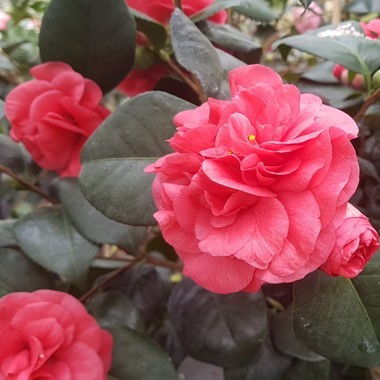Japanese camellia
(Adinandra integerrima)

Description
Camellia japonica, known as common camellia, or Japanese camellia, is a species of flowering plant in the family Theaceae. There are thousands of cultivars of C. japonica in cultivation, with many colors and forms of flowers. In the U.S. it is sometimes called japonica. In the wild, it is found in mainland China (Shandong, east Zhejiang), Taiwan, southern Korea and southwestern Japan. It grows in forests, at altitudes of around 300–1,100 metres (980–3,600 ft). Camellias are famous throughout East Asia; they are known as tsaa faa (lit. "tea flower") in Cantonese, cháhuā in Mandarin Chinese, tsubaki in Japanese, dongbaek-kkot in Korean, and as hoa trà or hoa chè in Vietnamese. The leaves of this species are rich in anti-inflammatory terpenoids such as lupeol and squalene. Camellia japonica is a flowering tree or shrub, usually 1.5–6 metres (4.9–19.7 ft) tall, but occasionally up to 11 metres (36 ft) tall. Some cultivated varieties achieve a size of 72 m2 or more. The youngest branches are purplish brown, becoming grayish brown as they age. The alternately arranged leathery leaves are dark green on the top side, paler on the underside, usually 5–11 centimetres (2.0–4.3 in) long by 2.5–6 centimetres (1.0–2.4 in) wide with a stalk (petiole) about 5–10 millimetres (0.2–0.4 in) long. The base of the leaf is pointed (cuneate), the margins are very finely toothed (serrulate) and the tip somewhat pointed. In the wild, flowering is between January and March. The flowers appear along the branches, particularly towards the ends, and have very short stems. They occur either alone or in pairs, and are 6–10 centimetres (2.4–3.9 in) across. There are about nine greenish bracteoles and sepals. Flowers of the wild species have six or seven rose or white petals, each 3–4.5 centimetres (1.2–1.8 in) long by 1.5–2.5 centimetres (0.6–1.0 in) wide; the innermost petals are joined at the base for up to a third of their length. (Cultivated forms often have more petals.) The numerous stamens are 2.5–3.5 centimetres (1.0–1.4 in) long, the outer whorl being joined at the base for up to 2.5 centimetres (1.0 in). The three-lobed style is about 3 centimetres (1.2 in) long. The fruit consists of a globe-shaped capsule with three compartments (locules), each with one or two large brown seeds with a diameter of 1–2 centimetres (0.4–0.8 in). Fruiting occurs in September to October in the wild.
Taxonomic tree:







